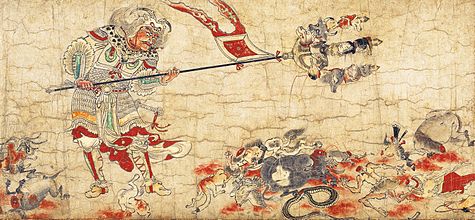
Back Goed en kwaad Afrikaans الخير والشر Arabic Добро и зло Bulgarian ভালো ও মন্দ Bengali/Bangla باشە و خراپە CKB Ырă тата усал CV Bono kaj malbono Esperanto Bueno y malo Spanish خیر و شر Persian Bien et mal (philosophie) French
This article has multiple issues. Please help improve it or discuss these issues on the talk page. (Learn how and when to remove these template messages)
|

In philosophy, religion, and psychology, "good and evil" is a common dichotomy. In religions with Manichaean and Abrahamic influence, evil is perceived as the dualistic antagonistic opposite of good, in which good should prevail and evil should be defeated.[1] Taoist philosophies typically perceive the world through a dualistic cosmological lens, where this dichotomy is a central concept, and often symbolized by the taijitu, commonly known as the "yin-yang".
Evil is often used to denote profound immorality.[2] Evil has also been described as a supernatural force.[2] Definitions of evil vary, as does the analysis of its motives.[3] However, elements that are commonly associated with evil involve unbalanced behavior involving expediency, selfishness, ignorance, or neglect.[4] Shakespeare once famously wrote the phrase, "There is nothing that is either good or bad, but thinking makes it so."[5]
The principal study of good and evil (or morality) is ethics, of which there are three major branches: normative ethics concerning how we ought to behave, applied ethics concerning particular moral issues, and metaethics concerning the nature of morality itself.[6]

- ^ Ingram, Paul O.; Streng, Frederick John (1986). Buddhist-Christian Dialogue: Mutual Renewal and Transformation. Honolulu, Hawaii: University of Hawaii Press. pp. 148–149.
- ^ a b "Evil". Oxford, England: Oxford University Press. 2012. Archived from the original on 2012-08-22.
- ^ Staub, Ervin (2011). Overcoming Evil: Genocide, Violent Conflict, and Terrorism. New York City: Oxford University Press. p. 32. ISBN 978-0195382044.
- ^ Matthews, Caitlin; Matthews, John (2004). Walkers Between the Worlds: The Western Mysteries from Shaman to Magus. Rochester, Vermont: Inner Traditions / Bear & Co. p. 173. ISBN 978-0892810918.
- ^ Shakespeare Quotes Poemanalysis.com. Hamlet, Act II, Scene 2, spoken by Hamlet. Retrieved Feb. 1, 2024.
- ^ Internet Encyclopedia of Philosophy "Ethics"
© MMXXIII Rich X Search. We shall prevail. All rights reserved. Rich X Search